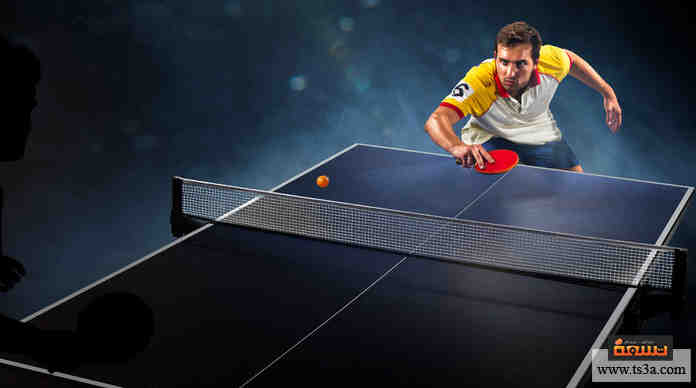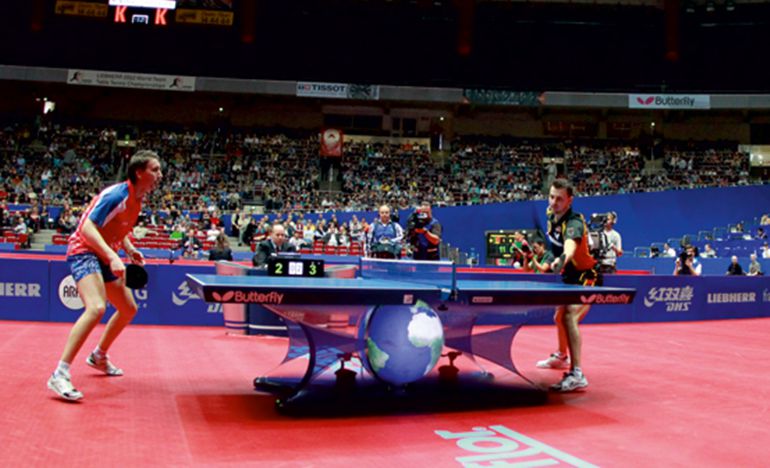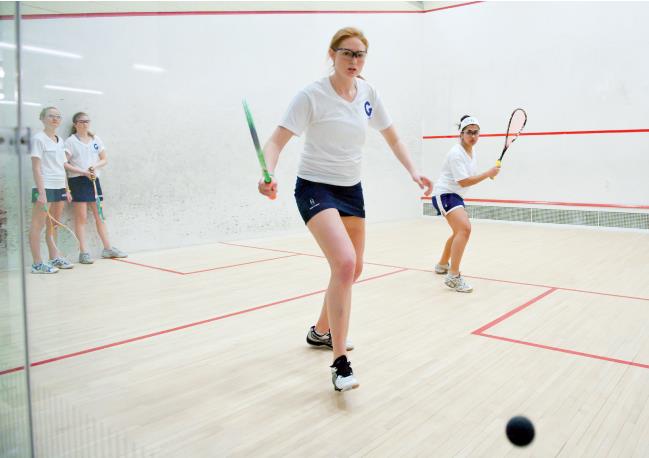Student Wellness Services
Racquetball Instructions and Videos
Introduction to Racquetball Rules and Play
TYPES OF GAMES
- Racquetball is played by two (singles) or four players (doubles).
- A variation of the game that is played by three players is called cut-throat. In cut-throat, one player serves and the other two players are his/her opponents. If the server wins the rally, they score a point. If they lose the rally, one of the other players becomes the server. The players take turns being the server as each player serving loses a rally.
OBJECTIVE
- The objective is to win each rally by serving or returning the ball so the opponent is unable to keep the ball in play. A rally is over when a hinder is called or when a player (or team in doubles): 1) is unable to hit the ball before it bounces twice, or 2) is unable to return the ball in such a way that it touches the front wall before it touches the floor.
POINTS AND OUTS
- Points are scored only by the serving side when it serves an irretrievable server (an ace) or wins a rally. In doubles, when the first server loses the serve, the second server then serves. After the second server loses the serve, it is a side out.
MATCH, GAME, TIEBREAKER
- A match is won by the first side winning two games. The first two games of a match are played to 15 points (win by one point). If each side wins one game, a tiebreaker game is played to 11 points (win by one point).
COURT SPECIFICATIONS
- The specifications for the standard four-wall racquetball court are:
- The dimensions of an indoor court are 20 feet wide, 40 feet long, and 20 feet high
- Outdoor courts may be shorter and without back walls
- All surfaces are in play, with the exception of any gallery opening, and surfaces designated as out-of-play for a valid reason (such as being of very different material or not in alignment with the back wall)
COURT MARKINGS AND USES
- Short Line: The short line is midway between the front and back walls. The serve must hit the front wall and then not bounce before crossing the short line in the air.
- Service Line: The service line is five feet in front of the short line. It is the line closest to the front wall.
- Service Area: The service zone is the 5’ x 20’ area bounded by the short line and a dashed line parallel to the short line (receiving line). The zone is observed only during the serve. Neither the server nor receiver may enter the zone until the ball has either hit the floor or crossed the line.
EYE GUARDS/WRIST TETHER
- All players must wear lensed eyewear and keep their wrist tether on at all times for their safety and the safety of their opponent. No matter how careful you are, you never know when you may be hit by an errant shot. Wearing eye guards also allows you to watch the ball at all times, which will keep you from being hit by your opponent and will let you anticipate better where they are hitting the ball to. ALWAYS WEAR EYE GUARDS WHEN YOU PLAY AND USE THE WRIST TETHER ON YOUR RACQUET!
HOW TO BEGIN PLAYING SERVING
- To start playing, you have to decide who will serve first. You can do this by lagging, coin toss, or any other method you choose. To serve, the server must drop the ball in the service zone and hit it after it takes one bounce. The server gets two chances to put the ball into play. A good serve means that the ball hits the front wall first and did not hit more than one other wall before hitting the floor beyond the short line. Bad serves are called either fault serves or out serves. If a server commits two fault serves, they lose the serve, or if they commit one out serve, they lose the serve.
EXAMPLES OF FAULT SERVES
- Short Service: the ball does not land over the short line.
- 3-Wall Serve: the ball hits more than two walls.
- Ceiling Serve: the ball hits the ceiling after hitting the front wall.
- Long Serve: the ball hits the back wall before hitting the floor.
- Screen Serve: the ball passes so close to the server’s body that the receiver cannot see it. The receiver must be in a good court position to make this call.
EXAMPLES OF OUT SERVES
- Two Consecutive Fault Serves: serving two fault serves as described above.
- Missed Serve Attempt: when the server drops the ball and swings at it, but completely misses it.
- Non-Front Wall Serve: any ball that does not hit the front wall first.
- Out of Court Server: if the ball goes out of the court before it hits the floor on the serve.
WHEN THERE IS A CHANGE OF SERVE
- A server is entitled to continue serving until one of the following occurs:
- They hit one Out serve.
- They hit two Fault serves in a row.
- They fail to keep the ball in play after their opponent’s return of serve.
ABOUT THE RALLY
- All of the lines on the court apply to serve and return of serve only and do not apply after a good serve has been returned and the rally has started.
- During the rally, opponents take turns hitting the ball to the front wall. Players may hit the ball directly to the front wall, or use any combination of the side wall, back wall, or ceiling, as long as the ball hits the front wall before touching the floor.
- The non-hitting team must yield the right of way to the hitter, including moving to worse court position if required.
- The hitter should stop play whenever they believe they may injure another player with the ball, racquet or body. This is called a Replay Hinder, causing the last rally to be replayed. Penalty hinders are also called during tournament play. See the full rules for an explanation of that type of hinder.
WINNING A RALLY
- A player wins the rally when their opponent does not make a good return by either:
- Two Bounce: Opponent could not return the ball before the second bounce on the floor
- Skip Ball: Opponent’s return hit the floor before touching the front wall
STUDENT HEALTH SERVICES
WELLNESS CENTER
SE WILL NOT DISCRIMINATE IN ANY EMPLOYMENT PRACTICE, EDUCATION PROGRAM, OR EDUCATIONAL ACTIVITY
ON THE BASIS OF RACE, COLOR, RELIGION, NATIONAL ORIGIN, SEX, AGE, DISABILITY, SEXUAL ORIENTATION,
GENDER IDENTITY OR VETERAN STATUS
ADA COMPLIANCE | WEB ACCESSIBILITY STATEMENT |
IT ACCESSIBILITY ACT | CIVIL RIGHTS & TITLE IX POLICY | STUDENT DISCLOSURE INFORMATION







